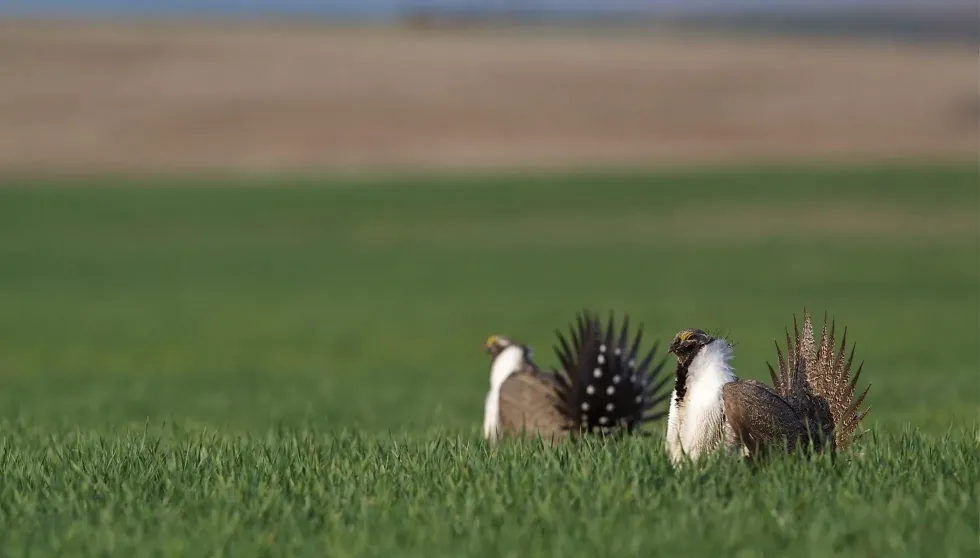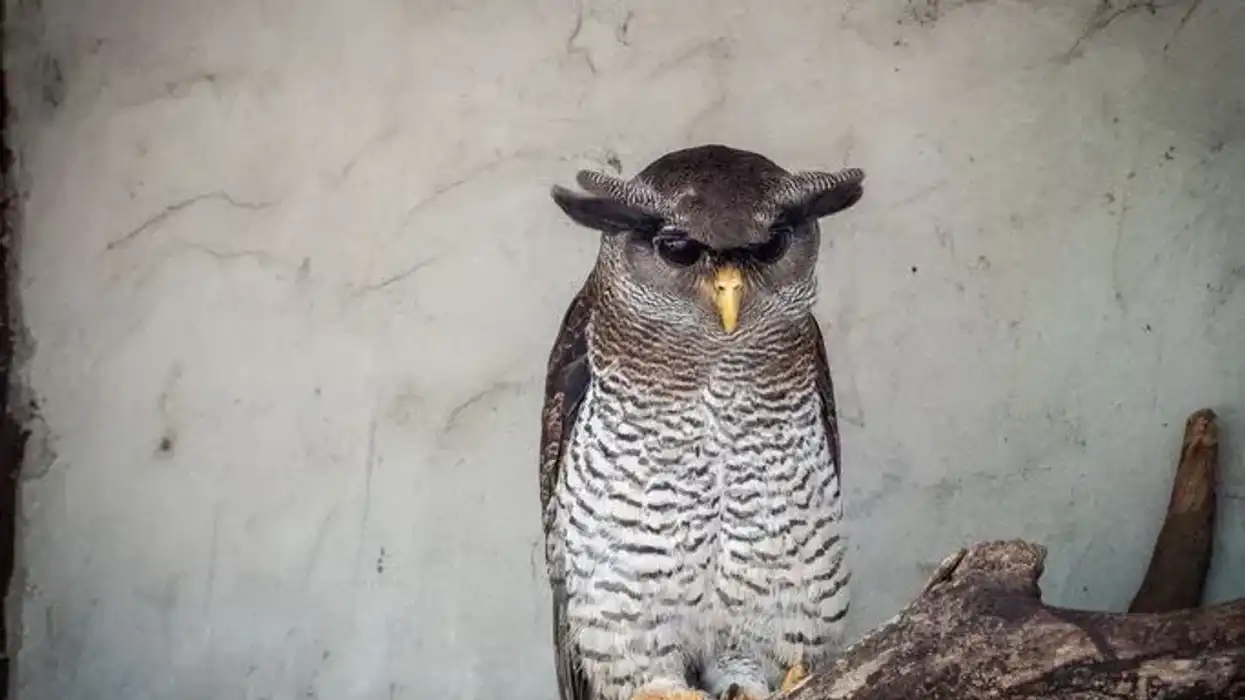Gunnison sage grouse, also called Gunnison grouse, are rare birds that are an Endangered or threatened species. Their scientific name is Centrocercus minimus and belong to the Animalia kingdom, Aves class, and Phasianidae family.
This bird is quite similar to the greater sage grouse and was considered the same species for a long time. This meant that this bird and the population of this species was overlooked for a long period of time until the 19th century.
The Gunnison sage grouse (Centrocercus minimus), similar to the greater sage grouse, is a very distinctive species in appearance due to its tail feathers, yellow inflatable air sacs, white-colored chest, filoplumes at the back of their heads, and a grayish brown plumage.
Apart from the physical appearance, these birds are also known for their lekking period where males compete to mate with females.
During this period, males begin to migrate to the lek locations.
The species is found in the habitat distribution range of North America, south-eastern Utah, and south-western Colorado. They eat based on the season, so this bird's diet changes in the summer, snowy winter, fall, and spring.
Continue reading this Gunnison sage grouse facts article for more interesting information about the population of this bird species.
You may also check out the fact files on spruce grouse and blue grouse from Kidadl.
Gunnison Sage Grouse Interesting Facts
What type of animal is the Gunnison sage grouse?
The Gunnison sage grouse is a rare social bird. It travels in flocks and occurs in the habitat range of North America, south-eastern Utah, and south-western Colorado. This bird was first given an individual identity in 2000 as before that, it was mistaken for the greater sage grouse.
What class of animal does a Gunnison sage grouse belong to?
This rare bird belongs to the animalia Kingdom and Aves class. They belong to the same family Phasianidae as sooty grouse and sharp-tailed grouse.
How many Gunnison sage grouses are there in the world?
Due to loss of habitat and other various reasons, the Gunnison sage grouse is an endangered species. Currently, only 5000 birds are left across eight areas including North America, southwestern Colorado, southeastern Utah, and the Gunnison Basin.
Where does a Gunnison sage grouse live?
Centrocercus Minimus currently falls under the Endangered species, but you might be able to locate them near the Colorado River and Utah. This bird adapts to temperate and terrestrial zones. Typically they are found in the savanna and grasslands in the Gunnison Basin.
What is a Gunnison sage grouse's habitat?
Gunnison sage grouse reside usually near sagebrush landscapes with areas having a diversity of grasslands and forbs. They prefer moist, wetland, irrigated pasture, and riparian habitats where they can feed their younger ones in summer.
Gunnisons stick to locations that are covered with massive black and big sagebrush all-round year which serves as a food source in winter and fall. Further, in addition to sagebrush, this species selects deciduous shrubs such as snowberry, Gambel oak, antelope bitterbrush as well as areas covered with juniper and pinyon.
The sage grouse (Centrocercus minimus) usually nests in dense areas that are covered with big sagebrush. They also prefer regions that include grass, rabbitbrush, and greasewoods. Leks are held in clear and open areas that consist of grassy swales, broad ridge tops, and dry lake beds in the Gunnison Basin.
Who do Gunnison sage grouse live with?
Gunnison grouse are social birds, and they fly for long distances to different places in search of food and protection. They do this all by traveling in groups called flocks. Currently, only 5000 birds are left for conservation across habitat range of eight ecosystem map areas including North America, southwestern Colorado, and southeastern Utah in the Gunnison Basin.
How long does a Gunnison sage grouse live?
Wild populations of Gunnison sage grouse have an average lifespan of three to six years, but they can also live up to nine years. The mortality rate of males in populations is greater compared to females and chicks.
This is because they have white and brown coloration that acts as camouflage amidst plants. It saves them from predators, whereas males in populations are big in size and have a flashy appearance.
How do they reproduce?
The sage grouse (Centrocercus minimus) follows the lekking process where the males compete in their behavior to get a female's attention to mate. These lek or breeding spots are near areas that have low sagebrush so that females can easily spot the males at lek spots.
Males travel to the lek spot every year and make popping noises or calls from their sacs. They also fout their tails in behavior as a way to impress the females for breeding.
After mating, males are no longer involved in the nesting or rearing. Females find a nesting region where they lay eggs which hatch after 25-27 days Female grouses raise young chicks all by themselves.
During this period, they live in areas that are covered with big sagebrush plants to help them and young chicks to camouflage to protect the from predators. Later they move from their nest to locations near the water where they can feed on insects for survival.
What is their conservation status?
The population status of the Gunnison sage grouse species is rapidly declining and is threatened due to fragmentation of habitats, low vegetative diversity, and invasive plant species. Additionally, the population of this bird has decreased by 90% in its former range.
The current number of this population is around 5000 and declining.
It is classified as an Endangered species by the International Union of Conservation of Nature (IUCN). Currently, only 5000 birds are left for conservation across eight ecosystem map areas including North America, southwestern Colorado, southeastern Utah, and the Gunnison Basin.
Gunnison Sage Grouse Fun Facts
What do Gunnison sage grouse look like?
Gunnison grouse looks similar to greater sage grouse but they have long feathers on their head and are relatively smaller. Male and female Gunnison grouse look different. A male bird has a distinctive look with two yellow air sacs on its white-colored chest and black-colored belly.
They blow up these throat sacs making popping sounds to attract females during courtship. Females are comparatively smaller in size with grayish-brown feathers that help them to camouflage. Also, they do not have breast sacs like males.
How cute are they?
Gunnison sage grouse are not very cute, but their unique features such as the tail feather, white breast, and yellow sacs can catch our attention.
How do they communicate?
These birds communicate by making noises and calls by inflating their air sacs during courtship behavior in lek spots, flapping wings, and signal each other with tail feathers. They do this to defend themselves or alert others when a threat is around.
How big is a Gunnison sage grouse?
The exceptional Centrocercus Minimus is 12-21 in (30.4-53.3 cm) and 25-30 in (63.5-76.2 cm) long. This bird looks similar to the greater sage grouse but is one-third smaller in size.
How fast can a Gunnison sage grouse fly?
Compared to other birds, grouse Gunnison sage is relatively heavy, but they are still decent fliers. They can fly up to 50 mph (80.4 kph). In order to escape from danger, flying is a better option for them as they have shorter legs that prevent faster running.
How much does a Gunnison sage grouse weigh?
The grouse Gunnison sage has a weight range around 1.9-5.2 lb (0.8-2.3 kg).
What are the male and female names of the species?
The male and female species do not have separate names, rather they are both called Gunnison sage grouses.
What would you call a baby Gunnison sage grouse?
These baby birds are called chicks or young Gunnison grouse.
What do they eat?
Depending on age and season, whether summer, snowy winter, or spring, a Gunnison sage grouse bird eats different things. One staple in their diet throughout the year is sagebrush plants.
Also, this species has weak digestive systems that do not allow them to feed on hard diet food such as seeds. Apart from sagebrush, Gunnison grouse eats insects and forbs that provide them sufficient protein to give to the young ones as well.
Are they dangerous?
These birds are not particularly dangerous or harmful to humans. They mostly defend themselves rather than attacking. If they feel their eggs or chicks are in danger, they will attack and drag their wings near the nest to chase away the predators.
Would they make a good pet?
Yes, the Gunnison sage grouse will make a good pet as they are not harmful and are human-friendly. Being an almost extinct species, these birds are hard to find and it is best to let them live in their natural habitat.
Did you know...
The lekking period takes place once a year. After this, a female bird lays six to eight eggs that hatch over a period of 25-27 days and nesting takes place.
The average chick weighs around 0.9-1 oz (25-30g) and cannot make sustainable flights until they are five to six weeks of age. Yearly mating and loss of habitats have resulted in decreasing population size.
Why is the Gunnison sage grouse endangered?
There are multiple reasons for the decrease in the number of the population of Gunnison sage grouse. One of which is the loss of habitats caused due to fragmentation.
Also, there has been an increase in human consumption of Gunnison sage grouse (Centrocercus minimus). This has led to a ban on hunting this bird species in Utah and Colorado to conserve them.
What animals eat sage grouse?
Gunnison sage grouse is an easy predator as they are heavy, large, and cannot run fast. Animals such as ground squirrels, American badgers, and coyotes often prey on their young.
Here at Kidadl, we have carefully created lots of interesting family-friendly animal facts for everyone to discover! Learn more about some other birds from our peach-faced lovebird and bohemian waxwing pages
You can even occupy yourself at home by coloring in one of our free printable Gunnison sage grouse coloring pages.









